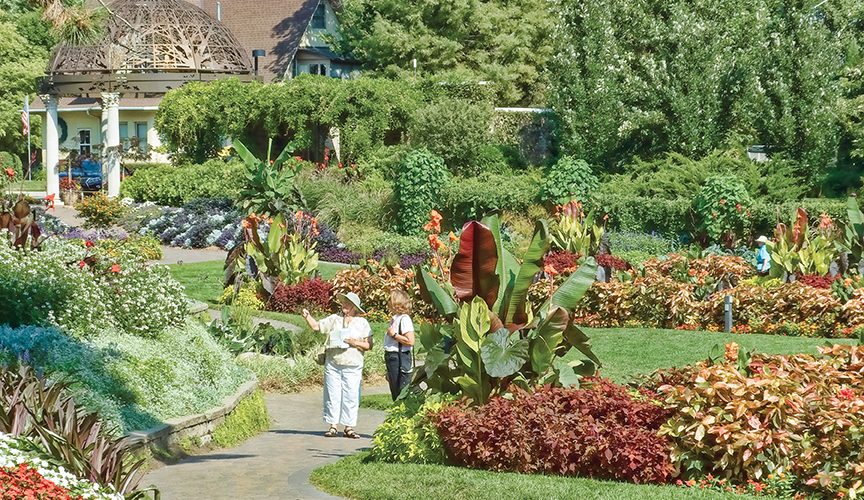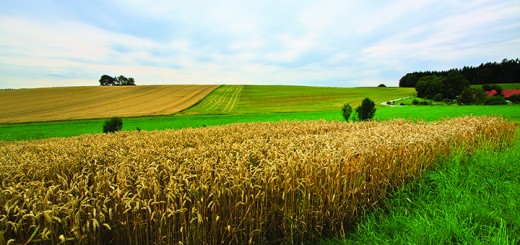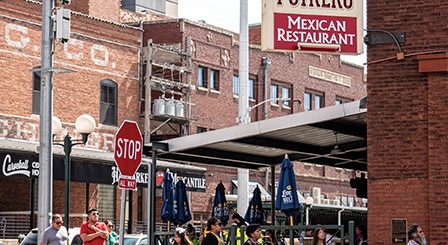Green Lincoln

by Julie Nichols
Lincoln is home to all things growing—especially community-driven outdoor spaces. Our public gardens green spaces and wild parks make neighborhoods richer, offer learning experiences about the natural world, provide colorful waystations and places to play, and offer intimate sites for special occasions, conversation and meditation.
Sunken Gardens
The tiniest but most celebrated of Lincoln’s public gardens, the Sunken Gardens at 27th Street and Capitol Parkway has a long and shifting history. Built on a refuse dump as a city project at the start of the Great Depression to provide work to the unemployed, it followed the 1930s trend toward rock gardens. Over the winter of 1930-31, stone was used to build terraced retaining walls, fountains and waterfalls. More than 416 trees and shrubs were installed and came to bloom the following season, less than a year after the project began. The tiered descent of the original version has been preserved, now planted with swaths of changing color.
Sunken Gardens surprises visitors and passersby each season with rotating themes and designs. A combination of exotics, perennials and annuals combine to give the gardens a feel that’s both formal and wild. The spring bloom begins with banks of tulips and the rise of perennials, soon joined by the foliage and flowers of thousands of annuals, the blooms timed to offer color and texture throughout the growing season.
By 2003, the garden was in need of a facelift and dedicated maintenance. More than $1.7 million was quickly raised through the Polishing the Gem campaign, and renovations completed in summer 2005 added restrooms, accessible entrances, walkways and parking. The popular lily ponds were renovated, the waterfall restored and new sculptural elements added. New lawn areas and a domed entry pavilion provide more space for special events.
Each spring, volunteers and park staff plant more than 30,000 annuals during Wake Up the Beds. In November, Putting the Beds to Bed brings volunteers together again to remove the summer’s plants and prepare the beds for next spring’s planting.
Themes guide color and variety each year—from enormous tropical banana plants, papyrus and massive elephant ears to tufts of native grasses and Plains perennials. Sun Salutations, 2019’s theme, showcased fiery oranges, reds and yellows.
At the top of the gardens, above the waterfalls and curving sidewalk, shade perennials—hosta, viburnum and hydrangea—grow beneath evergreens, flanking the popular Rebekah at the Well, a contemplative bronze figure of a girl pouring water. The Healing Garden, inspired by the White Garden of Sissinghurst Castle, Kent, England, is on the upper west side. The concentration of white blossoms provides a place for contemplation, especially magical on moonlit summer nights. Kids are drawn to the lily ponds to watch brightly colored koi.
With Lincoln’s large immigrant community, it’s not unusual to hear a dozen languages spoken by neighborhood residents and regular visitors. Mornings offer a time for peaceful walks, and evenings draw families and those seeking the dramatic color changes at sundown.
The proximity of Sunken Gardens to Antelope Park Triangle, Hamann Rose Garden and Children’s Zoo provides a variety of activities for all ages. Admission is free, but donations are accepted. Sunken Gardens is open daily 6 a.m.-11 p.m. Restrooms are closed during the winter.
Garden tour docents are available for tours of Sunken Gardens, Hamann Rose Garden and Strolling Garden. To reserve the gardens for a wedding or special event, check the online reservation system at lincoln.ne.gov/city/parks/parksfacilities/publicgardens/sunken/index.htm
Hamann Rose Garden
Just across 27th Street from the Sunken Gardens, the Hamann Rose Garden in Antelope Park is planted on what once was a hayfield that produced feed for Parks Department workhorses. In summer bloom, the rose garden is a feast of color and scent, and a must-see for rose enthusiasts.
When the land was converted to Nebraska’s first test gardens in the 1940s, the original rose garden was named for Sunken Garden designer Fred Goebel. A small area, originally dedicated to see how 200 rose varieties survived Nebraska’s intense climate, has now grown to contain more than 123 varieties of hardy roses. Redesigned by Ernst Heminghaus, the designer of Pioneers Park, the rose garden’s purpose was to teach visitors about the many roses tough enough to withstand Nebraska’s harsh winters and humid summers. Now renamed the Hamann Rose Garden, it is planted in both a formal garden and informal beds that merge with other plantings in Antelope Park.
Local jeweler and rose enthusiast Don Hamann donated generously to a 2006 effort by the Lincoln Rose Society, Lincoln Parks Foundation and Lincoln Parks and Recreation that raised more than $350,000 for renovations.
More than 1,300 roses of varied color and fragrance adorn the formal garden, including recent award-winning roses, hybrid teas, miniatures, floribundas and grandifloras in the tradition of Goebel. Seating areas and lighting make the garden accessible into the evening. The garden also features an ornamental gate, a pavilion, iron fencing and various sculptures. A fountain topped by a bronze cherub is found at the center.
The informal Rotary Strolling Garden to the northeast integrates bush roses with drought-resistant companion plantings and provides soft transition to the trees and mass plantings around Teacher’s Fountain at the corner of 27th Street and Capitol Parkway.
Veteran’s Memorial Garden
Within Antelope Park, at 3200 Veteran’s Memorial Drive, visitors can see 37 memorials, tributes and benches honoring fallen veterans.
Purple Heart recipients, Women Airforce Service pilots, disabled veterans, Tuskegee Airmen, Buffalo Soldiers, MIA/POWs—any veteran, living or dead, as well as Gold Star Families—can be acknowledged through a Brick of Honor. All proceeds go to improvement and maintenance of the memorials. Admission is free; to donate, see natlvtn.org/veterans-memorial-garden/ or call 402-441-8258.
Garden hours are 6 a.m.-11 p.m. daily; restrooms are available April-October. For more information see parks.lincoln.ne.gov (keyword: veterans garden).
University of Nebraska
Gardens/Maxwell Arboretum
More than half a century ago, Earl G. Maxwell began planting trees along a creek on the University of Nebraska’s East Campus, home of agricultural, horticultural, natural resources and food science studies. Maxwell’s small farm became the first experimental acreage for the university. Now a five-acre woodland of impressive diversity, the Maxwell Arboretum and its integrated gardens show specialized collections of woody plants, trial sites for new cultivars and mass plantings of prairie and ornamental plants.
Enter via the Karl Loerch Gazebo and meander through specimen trees. Chestnuts and blue ash mark the perimeter along Holdrege Street.
Walking the paths branching away from the street takes visitors through striking and unusual specimen trees, including black gum and paw paw, set among a collection of massive oaks. Sectors of the arboretum are dedicated to specialized gardens, but the landscape also integrates special collections of hosta, lilacs, iris, viburnum, as well as trial sites for native prairie plants and cultivars in development.
Managed by the University of Nebraska-Lincoln Botanical Garden and Arboretum, UNL Landscape Services’ mission is to develop, manage and maintain the botanical resources of the campus, including the gardens and arboretum. In response to the educational mission of the University of Nebraska, the Landscape Services Department provides educational programs and events, garden tours and interpretive materials focusing on the campus landscape and botanical gardens.
For more information about UNL’s gardens, Maxwell Arboretum and the Nebraska Statewide Arboretum, see unl.edu/bga/home.
Union Plaza/Antelope Valley Corridor
Both unconventional and practical, Union Plaza’s six acres of urban park focus on the changing nature of water and the need for its conservation. Built in partnership with the Antelope Valley flood and road way project, the park at 21st and O streets in the heart of Lincoln connects to city trails offers a festival space and amphitheater. The multi-level park gives children and families play areas and climbing spaces among informal plantings with hidden animals waiting to be discovered. Hiking and biking trails connect O Street with the University of Nebraska-Lincoln’s Innovation Campus to the north.
Four fountains, a meandering stream, planters and pavement reflect the pervasive nature of water, evoking droplets, ripples and splashes. Shapes in the walkways reflect the routes of streambeds present long before the city was built. Conservation of groundwater is reflected through permeable pavement and run-off structures that route water to street-side trees. Sustainable LED lights and water-conserving nozzles illustrate a commitment to preserve our most precious resource.
Each block of the park focuses on natural ecological systems and communities. Flora and fauna of Nebraska are represented in murals set into the retaining walls. In another stretch of the park, the humans that inhabited the Plains are memorialized through murals depicting Native tribes and pioneers.
Union Plaza also displays two major works of public art. On the west side, Groundwater Colossus by James Tyler personifies Nebraska’s Oglala Aquifer, the largest underground water source in North America. A massive stone head with an inscrutable gaze, Colossus radiates the sounds of trickling water and clanging metal, juxtaposing both the gift of water and the effects of human activity on the environment. Discover, by artist Shannon Hansen, stands on the east side of the park, and visitors can see the State Capitol through its frame.
Through recent intense floods, Union Plaza/Antelope Valley has proved its effectiveness as a flood-control structure. But its lasting value as a stimulus for community and neighborhood unity and development is undeniable. The Jane Snyder Trails Center offers public meeting space, restrooms and community health offices.
In the retail space that is part of the Trails Center, Hub Café serves creative cuisine using responsibly produced local ingredients and is a delicious start or finish to Union Plaza visits. An outdoor dining space provides an overlook to the park.
For more information on events or amenities, visit the website at LincolnUnionPlaza.org. Parking is available by the Hub Café/Jane Snyder Center or the playground north of P Street.
Pioneers Park
Pioneers Park offers visitors an array of activities focused on education, conservation and enjoyment of Nebraska’s natural world. The park on the southwest edge of Lincoln offers trails, playground, prairie, picnic structures and a sledding hill. Trails through grassland and forest accommodate horse riders, pedestrians and cyclists. Pinewood Bowl, an outdoor amphitheatre, hosts concerts from spring through fall.
The park at 3201 S. Coddington Ave. began with 1,100 acres given to the city in 1928. A popular sculpture of a life-sized bronze bison, stands inthe traffic circle at the main park entrance on west Van Dorn Street. Another, Smoke Signal, captures the likeness of Chief Red Cloud lifting his blanket over a signal fire. A Works Progress Administration project built by sculptor Ellis Luis Burman of bronze-tinted cast stone, the monument was dedicated in 1935 in the presence of four Native American men on horseback. Smoke Signal sits on the crest of a hill and offers visitors a panoramic view of the park.
A favorite spot for photographers, the Treasury Columns stand near the woods at the bottom of a sweeping hill on the north side of the park. Made of porous sandstone, the massive ionic columns once stood in front of the U.S. Treasury. By 1908, all 30 of the columns showed signs of decay and were abandoned in a vacant lot. In 1916, four were shipped and installed at great cost in honor of Nebraska’s famed politician, William Jennings Bryan.
Within the park, Pioneers Park Nature Center was originally a 40-acre wildlife sanctuary called the Chet Ager Bird and Wildlife Nature Study Sanctuary. It has grown to include two interpretive centers and more than 600 acres of woodlands, wetlands and prairie habitat. The nature center has more than eight miles of trails.
The Chet Ager Center, built in 1963, houses a small collection of Nebraska fauna, including reptiles and amphibians. The Prairie Building is equipped with classrooms, auditorium and exhibit space for the Nature Center’s education programs. Built with sustainable features, the Prairie Building is just across the road from Chet Ager, adjacent to the Hands-on Prairie, a restored tall-grass ecosystem.
The Nature Center’s preschool and pre-K program is a school, but one where kids can get dirty, feel a snake’s skin, learn how feathers keep birds in flight and observe growth cycles of insects and plants. Outside the Prairie Building, the children and their families plant a butterfly garden each year with colorful annuals that attract pollinators.
About 30 trained interpretive staff members are available to lead children, scouts and visitors in natural history programs. Every fourth-grader in Lincoln Public Schools attends the Heritage School set in a restored one-room schoolhouse to get a taste of what a school day was like for pioneer children.
Near the Chet Ager Building, the Louise Doole Herb Garden showcases more than 150 varieties of herbs, and several programs throughout the year teach visitors culinary uses and their historical use in medicine.
North of the Hands-on Prairie lies the Martin Prairie, which extends all the way to West Van Dorn Street since 228 acres were added in 2005. The Hilltop Prairie, purchased in 1999, added another 80 acres of grassland to
the park.
Admission to Pioneers Park is free; donations are accepted. Hours of operation: Monday-Saturday, 8:30 a.m.-5 p.m.; Sundays noon-5. Facilities close at 4:30 in the fall. Open every day except Thanksgiving, Christmas and New Year’s. Traffic entrances are Coddington on the east and West Van Dorn on the north. See a map at lincoln.ne.gov/city/parks/naturecenter/links/trailmap.pdf. Call the Nature Center at 402-441-7895.
Wilderness Park
Wilderness Park lives up to its name. Separated into several branches southwest of Lincoln, this park is a mostly public nature conservancy, and its nearly 1,500 acres make it the largest in Lincoln. Minimally developed, Wilderness Park’s topography and accessibility changes through natural shifts of Salt Creek’s course through seasons of flooding and erosion. The thick woodlands provide habitat for wildlife from foxes, deer and raccoons to songbirds, owls, frogs, small fish and aquatic invertebrates. Under the canopy, shade plants and fungi thrive, and students of all ages find plenty to study within the park.
Wilderness Park is a haven for naturalists and an escape from the city. A vast network of dirt trails, single-track bike trails and horse trails weaves through the park, each marked for specific use. Jamaica Trail North, a crushed limestone trail bike trail, connects to the Homestead Trail corridor that can take cyclists more than 40 miles south to Beatrice and will ultimately extend to Marysville, Kansas.
Wilderness Park lies between South First Street on the west side, Van Dorn Street on the north, 27th Street on the east and Saltillo Road on the south, where segments of the park are the widest…and the wildest.
Admission is free. More, lincoln.ne.gov/city/parks/parksfacilities/parks/wilderness.htm.




Recent Comments